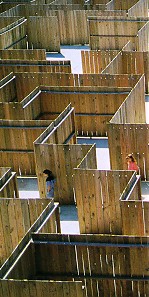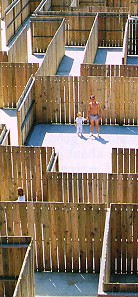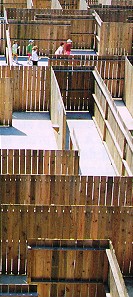The object in Maze Mania is go into the entrance to the maze, find the “cheese” hidden in one of the plazas (actually it's a machine that prints a picture of cheese on your time card), then find the separate exit from the maze. Having a goal (in this case, the cheese) inside the maze is a way of defeating the right-hand-rule algorithm. A lot of people know this algorithm (you put your right hand on a wall and just follow it around), but it doesn't solve every maze. If you use it, and it does solve a maze, then you will have solved the maze without having any fun.
“So,” you'll probably ask, “what maze should I visit if I won't be anywhere near Myrtle Beach?” I don't really have a good answer for this. I can point you toward a fairly complete list of all the mazes in this country (and in the world). Go to
www.mazemaker.com and click on the section called “Adrian Fisher's World Maze Database.” Besides the list of mazes, this is a fascinating site with lots of general information about mazes. Also check out
www.americanmaze.com. This site will give you a list of most of the cornfield mazes that will be around this summer. Cornfield mazes are a lot of fun, even when they aren't too well-designed.
Of the mazes I've visited, the chief flaw I've found is poor handling of false paths. A lot of designers think you just have to draw a true path to the goal, have various false paths branch off the true path, and have each false path go directly to a dead end. A maze like this is boring and easily solved. That flaw is most obvious in a large maze in Panama City Beach, Florida, and in the old maze in Vacaville, California. A better way to handle false paths is to have them lead into loops, or to other false paths. Even better is to have a section of inter-connecting paths that you can wander around in. There should be only one exit from this section, and it should take you to another section of inter-connecting paths. Another flaw is to have multiple goals to visit (at each goal there's a machine that punches a number on your time card). That flaw is in many mazes, including one in Daytona Beach, Florida. With multiple goals, you just wander at random and you're sure to come across one goal after another. The worst flaw happens when a designer creates a very large maze (like one of the large cornfield mazes). The designer then realizes the maze is too hard, so he puts in two or more separate solutions to the maze. And, finally, a maze should not be solvable by the right-hand rule.
In spite of all these flaws, I hope you visit a maze this summer. Even a poorly-designed maze can have some interest. I've visited most of the mazes on the East Coast, but I haven't visited any in Colorado or in Southern California, so there might be some good mazes that I don't know about in these areas. And I'd like to propose a project: If you do visit a maze, write a review, or just a short evaluation, and send it to me. I'll print some reviews in this column, and, if we receive enough reviews, we can print an entire guide to mazes before next summer.


 The best-designed maze I know is the brilliant Maze Mania, shown at the left. It's in the town of Garden City, just south of Myrtle Beach, South Carolina. A unique feature of Maze Mania is it has several open areas, or plazas, inside the maze. Entering one of these plazas is a pleasant visual experience, and since there are about four exits from each plaza, you are presented with many choices at one time.
The best-designed maze I know is the brilliant Maze Mania, shown at the left. It's in the town of Garden City, just south of Myrtle Beach, South Carolina. A unique feature of Maze Mania is it has several open areas, or plazas, inside the maze. Entering one of these plazas is a pleasant visual experience, and since there are about four exits from each plaza, you are presented with many choices at one time.